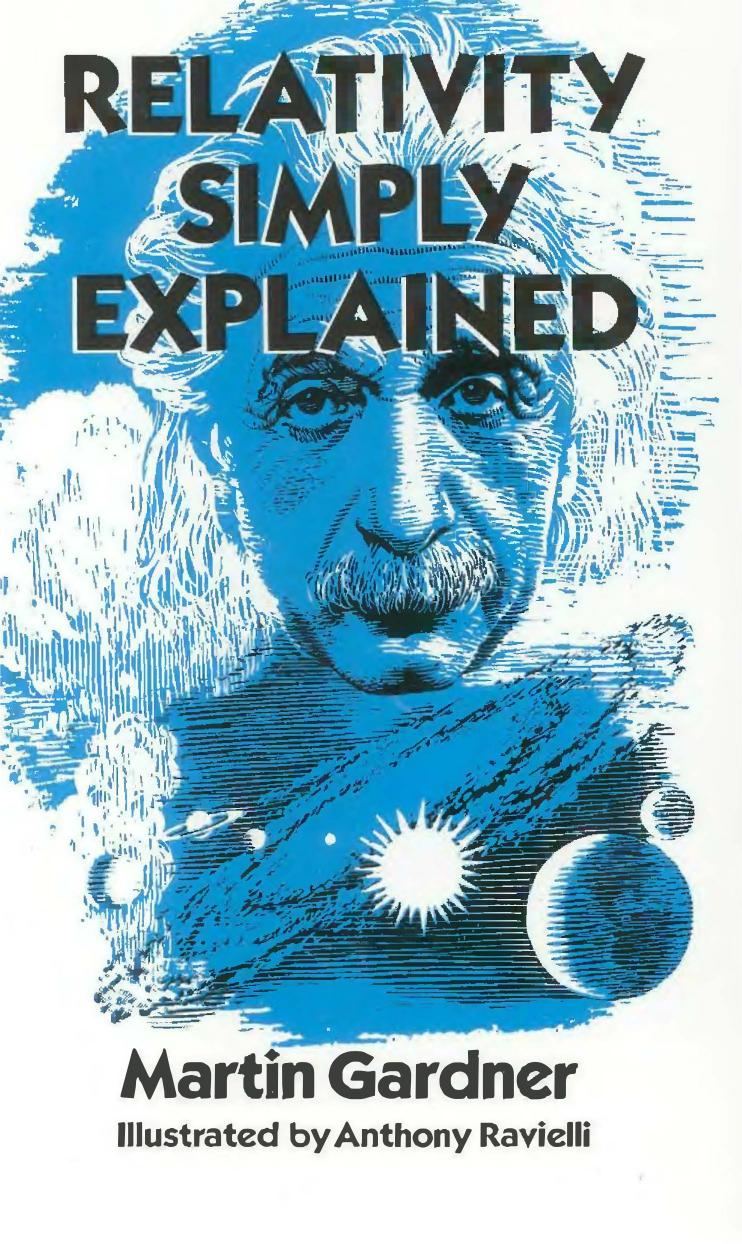Relativity Simply Explained by Martin Gardner

Author:Martin Gardner
Language: eng
Format: epub, pdf
Publisher: Dover Publications
Published: 2014-03-09T16:00:00+00:00
The ship starts to move in the direction of the ceiling with an acceleration of one g. (A “g” is the acceleration with which bodies fall to the earth.)
What happens to the apple?
From the standpoint of an observer outside the ship, attached to the inertial frame of the cosmos, the apple should stay right where it is relative to the stars. No force is acting on it. The ship itself does not touch the apple; the ship might just as well be a thousand miles away. The floor of the compartment should, therefore, move up until it hits the apple. (We don’t have to worry, in this thought experiment, about what happens when the floor hits the apple.)
The situation is altogether different if the ship is taken as a fixed frame of reference. Now the observer must suppose a gravitational field acting inside the ship. This would send the apple toward the ceiling with an acceleration (relative to the stars) of two g. A basic principle of relativity has been violated: The two frames of reference are not interchangeable.
In other words, negative gravitational mass is difficult to reconcile with general relativity, although Newton’s approach to inertia accommodates it easily. Classical physics simply takes the first point of view. The ship has an absolute motion with respect to the ether. The apple remains at absolute rest. No gravitational field enters to complicate the picture.
It is important to realize that relativity is in trouble only when one type of mass is positive, the other negative. A body with both masses negative introduces no contradictions, although its behavior would be surprising.* A moving baseball made of such matter could be caught in a glove only by slapping it hard in the direction in which it is moving. However, the ball would fall to earth in the normal manner. In the case of a falling ball made of ordinary matter, the gravitational attraction between it and the earth is balanced by the drag of its inertial mass. In the case of a falling ball with both masses negative, the gravitational repulsion between it and the earth is balanced by the pull toward the earth of its inertial mass. Therefore it, too, falls normally in the earth’s gravitational field.
Download
Relativity Simply Explained by Martin Gardner.pdf
This site does not store any files on its server. We only index and link to content provided by other sites. Please contact the content providers to delete copyright contents if any and email us, we'll remove relevant links or contents immediately.
The Complete Stick Figure Physics Tutorials by Allen Sarah(6638)
Secrets of Antigravity Propulsion: Tesla, UFOs, and Classified Aerospace Technology by Ph.D. Paul A. Laviolette(3450)
Thing Explainer by Randall Munroe(3328)
The River of Consciousness by Oliver Sacks(2992)
The Order of Time by Carlo Rovelli(2714)
I Live in the Future & Here's How It Works by Nick Bilton(2524)
How To by Randall Munroe(2476)
A Brief History of Time by Stephen Hawking(2473)
The Great Unknown by Marcus du Sautoy(2186)
What If?: Serious Scientific Answers to Absurd Hypothetical Questions by Randall Munroe(2170)
Blockchain: Ultimate Step By Step Guide To Understanding Blockchain Technology, Bitcoin Creation, and the future of Money (Novice to Expert) by Keizer Söze(2137)
Midnight in Chernobyl by Adam Higginbotham(2078)
Networks: An Introduction by Newman Mark(1998)
The Meaning of it All by Richard Feynman(1909)
Easy Electronics by Charles Platt(1864)
The Tao of Physics by Fritjof Capra(1850)
When by Daniel H Pink(1777)
Midnight in Chernobyl: The Untold Story of the World's Greatest Nuclear Disaster by Adam Higginbotham(1775)
Introducing Relativity by Bruce Bassett(1754)
